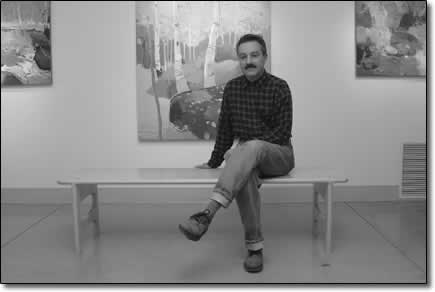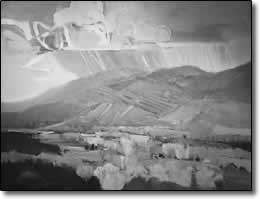Artist John Maxon discusses California, community and creativity

|
|
John Maxon rests in front of his oil-on-canvas landscape entitled "Aspen Grove," now on display at Fort Lewis College./Photo by Todd Newcomer
|
by Jules Masterjohn
The history of art encompasses numerous stylistic movements and schools, which have been
influenced by the social, political and technological trends of the times. Beginning in the mid-to late-1900s, the
San Francisco Bay area became a hotbed of intellectual activity, influenced by Eastern art and aesthetics. The Zen
philosophical perspective that revealed "less is better" led to a minimalist attitude among many artists. In the Los
Angeles area, light and its perception became of interest to some. These forces and factors enabled West Coast
artists to step into a place of innovation and visibility in the American art scene that they had not yet enjoyed. It
was an especially juicy and dynamic time in the West Coast art world.
Painter, printmaker, sculptor and Fort Lewis College instructor John Maxon was attending art schools in the Bay Area
during the late '60s and early '70s. Recently, we talked about the importance of those times and what he has carried
with him to this day that influence his life and art making.
JM: John, how did this particular artistic climate influence you?
MAXON: During undergraduate school, materials were considered "king," and people tried to learn all about the new
ones, like plastics and metals, and how to combine them. Also acrylics were just coming into use. There was a lot of
emphasis on technique and the whole intellectual approach to art, where the idea was more important than the art
object itself. For a while I tried making heady art, but it didn't fit my personality.
In graduate school at UC Davis, my interactions with my instructors, Wayne Thiebaud, William T. Wiley and Roy
DeForest, were influential in giving me a strong awareness of the dedication and strength that it takes to make a
career as an artist.
JM: As an artist, you have said that you "paint from your heart."
MAXON: Yes, for me, art serves as a reflection of my own spirit and its interconnectedness to
all things. Leonardo da Vinci wrote, "Where the spirit does not work with the hand there is no art." I am interested
in what people get moved by and in trying to find honesty in my own process. As an artist, I am doing the best I can
to react to my environment, working with things that are important to me by putting love into them and struggle into
them. Hopefully not so much struggle that it becomes awkward to look at. As an artist, I work through the struggle,
and there's a release and then a freedom that I, myself, feel through the process. Hopefully the viewer will feel the
same thing, and that's where the human connection is made.
JM: Beauty is something that hasn't been talked about much in academic institutions since the '60s.
Is it important to you?
MAXON: I am interested in beauty as a description against something that is totally intellectual, that beauty is
something connected to the heart. Beauty is subjective, obviously; what I find beautiful may not be what you find
beautiful. For me, nature can stimulate this sense of beauty, and things get awakened when I am in nature. I go into
nature for thoughtful interaction, to encourage deep thoughts to come. It is spiritually quieting and uplifting.
JM: Are you trying to express the beauty you find in nature through your landscape paintings?
MAXON: I am interested in moving someone to the core of their being, not that they have to be
knocked off their feet, but that they pick up on that vibration that is awakening something in them. When that
happens, that particular piece of art is probably doing what it should be doing, which is communicating.

|
|
John Maxon's oil on canvas "Summer Showers."/Photo by Todd Newcomer
|
MAXON: I am interested in moving someone to the core of their being, not that they have to be
knocked off their feet, but that they pick up on that vibration that is awakening something in them. When that
happens, that particular piece of art is probably doing what it should be doing, which is communicating.
JM: What do you see today's students trying to communicate through their art?
MAXON: I think that when you are young, finding different avenues of expression is part of
what is becoming important to them and to find their greater place within one's community.
JM: Perhaps they are trying to find unique and meaningful ways to express themselves?
MAXON: Yea, which art is it's a therapy. It's certainly a therapy for artists. Art may be a
therapy for the viewer, as well.
JM: Therapeutic in the sense that it brings understanding?
MAXON: Therapy in the sense of talking with oneself. The better that you are at going to that
inner voice, the closer you are to the center of yourself. This is what I am talking about when I say that I'm
working toward something that is truthful in my art.
JM: As a teacher, is this truthful interaction something you want to encourage in students, to
cultivate?
MAXON: The best thing I can do is to help them understand that they have an important inner
vocabulary and to find a way to get in touch with their inner creative voices. I know a lot of techniques that can be
very helpful when someone is trying to convey a visual statement and is frustrated by the process. I can encourage
them not to stay in the frustration. Within that moment of us working together in a visual art situation it's
awakening their inner spirit. I try to allow them to recognize those moments of lucidity. Those are the moments when
joy - a thoughtless, more experiential state - actually takes place. If we can learn how to stay more and more in
touch with those moments, joy can become a daily activity.
JM: You are describing a philosophical stance that speaks to a bigger purpose for the art-making
process.
MAXON: The purpose is to live life with as much joy and care for other human beings as
possible, to paint the struggle, paint the joy, above all paint the truth.
John Maxon is represented by Ellis Crane Gallery in Durango. His paintings also are on display in a two-person show
with jeweler Peggy Maloney through Feb. 18 at the Fort Lewis College Art Gallery. An artists' reception takes place
Fri., Feb. 4, from 5-7 p.m.
|